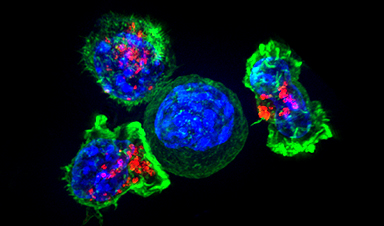Nanoparticles, or tiny molecules that can deliver a payload of drug treatments and other agents, show great promise for treating cancers. Scientists can build them in various shapes with different materials, often as porous, crystal-like structures formed by a lattice of metal and organic compounds, or as capsules that enclose their contents inside a shell. When injected into a tumor, these particles can release treatments that attack cancer cells directly or complement other treatments like immunotherapy and radiation.
“This was an unusual collaboration between medicine and inorganic chemistry to solve this unmet need of treating tumors that are intractable to conventional therapy,” said Ralph Weichselbaum, MD, the Daniel K. Ludwig Distinguished Service Professor and Chair of Radiation and Cellular Oncology at UChicago. “We were able to deliver an immune stimulant that has anti-tumor activity on its own, and enabled radiation and immunotherapy to cure these tumors.”
The study, “Zinc cyclic di-AMP nanoparticles target and suppress tumors via endothelial STING activation and tumor-associated macrophage reinvigoration,” was published in Nature Nanotechnology on October 26, 2022.
Cold, hot, and hotter tumors
As always with cancer, some tumors prove resistant to even the most high-tech of treatments. Immunotherapy unleashes the body’s immune system to find and destroy cancer cells, but the tumors must be “hot” or inflamed for these treatments to be effective. So called “cold” tumors that aren’t inflamed can hide from the immune system but continue to grow and metastasize.
In a pair of studies published in 2014, Weichselbaum and other UChicago researchers showed that mice that lacked a protein pathway called STING did not mount an effective immune response to cancer in conjunction with immunotherapy or high-dose radiation treatment. STING, short for Stimulator of Interferon Genes complex, is a crucial part of the process the immune system relies on to detect threats–such as infections or cancer cells—that are marked by the presence of DNA that is damaged or in the wrong place, inside the cell but outside the nucleus.
Wenbin Lin, Ph.D., the James Franck Professor of Chemistry at UChicago, specializes in building nanostructures that can deliver a variety of compounds to tumors. Nanoparticles tend to get trapped in tumors because of their haywire vasculature and lymphatic systems, thus they can deliver more of their payloads exactly where needed. Lin has developed a new type of particle called nanoscale coordination polymers (NCPs) that have a non-toxic zinc phosphate core surrounded by layers of lipids. These NCPs have the advantage that they can be engineered for controlled release, further increasing drug deposition in tumors.
Lin, who is trained as an inorganic chemist, says he is in a unique situation working on medical treatments because of his experience designing particles with different properties. “It’s a unique technology that is well-suited for delivering many drug agents. We already know how to modify the surface so they can circulate in the blood and not be engulfed by macrophages,” he said.
A versatile technology
In the new study, Weichselbaum and Lin’s teams loaded the NCPs with a nucleotide called cyclic dimeric adenosine monophosphate (CDA). CDA is a bit of DNA that bacteria generate when they invade a host; its sudden appearance—whether by infection or dropped off by a nanoparticle—triggers the STING pathway and the host’s innate immune response to fight the cancer.
This boosted immune response attacked the tumors in multiple ways, suppressing tumor growth and preventing metastasis in several types of cancers. It disrupted endothelial cells in the blood vessels of tumors, further increasing the deposition of CDA in tumors. Surprisingly, it also enhanced the ability of tumor-associated macrophages that had infiltrated tumors to present antigens that mark them for attack by anti-tumor T-cells.
In addition, this approach made non-inflamed, cold pancreatic tumors more susceptible to immunotherapy treatment. It was also effective against glioma, effectively crossing the blood-brain barrier to reverse resistance to immunotherapy and enhance the effects of radiation treatments.
“That’s the brilliant part of these nanoformulations. We were able to encapsulate a STING agonist that is extremely potent and promotes both innate and adaptive immunity,” Weichselbaum said.
Lin, who has formed a startup company called Coordination Pharmaceuticals to develop NCPs, is enthusiastic about their potential for more clinical uses.
“This has tremendous potential because we’re not limited to a single compound. We can formulate other nucleotides and use other drugs in the same NCP,” he said. “The technology is versatile, and we are exploring ways to optimize formulations to take more NCP candidates into clinical trials. Small startups can advance clinical candidates in a much shorter amount of time than big drug companies.”
The study is titled “Zinc cyclic di-AMP nanoparticles target and suppress tumors via endothelial STING activation and tumor-associated macrophage reinvigoration.” Additional authors include Kaiting Yang, Wenbo Han, Xiaomin Jiang, Andras Piffko, Jason Bugno, Hua Liang, Ziwan Xu, Wenxin Zheng, Liangliang Wang, Jiaai Wang, and Xiaona Huang from the University of Chicago; Chuanhui Han from Peking University, China; Sirui Li and Jenny P. Y. Ting from the University of North Carolina at Chapel Hill; and Yang-Xin Fu from Tsinghua University, China.
News
Two New Books From Frank Boehm, NA Founder – To be Released Dec. 2025
Molecular Manufacturing: The Future of Nanomedicine This book explores the revolutionary potential of atomically precise manufacturing technologies to transform global healthcare, as well as practically every other sector across society. This forward-thinking volume examines [...]
What could the future of nanoscience look like?
Society has a lot to thank for nanoscience. From improved health monitoring to reducing the size of electronics, scientists’ ability to delve deeper and better understand chemistry at the nanoscale has opened up numerous [...]
Scientists Melt Cancer’s Hidden “Power Hubs” and Stop Tumor Growth
Researchers discovered that in a rare kidney cancer, RNA builds droplet-like hubs that act as growth control centers inside tumor cells. By engineering a molecular switch to dissolve these hubs, they were able to halt cancer [...]
Platelet-inspired nanoparticles could improve treatment of inflammatory diseases
Scientists have developed platelet-inspired nanoparticles that deliver anti-inflammatory drugs directly to brain-computer interface implants, doubling their effectiveness. Scientists have found a way to improve the performance of brain-computer interface (BCI) electrodes by delivering anti-inflammatory drugs directly [...]
After 150 years, a new chapter in cancer therapy is finally beginning
For decades, researchers have been looking for ways to destroy cancer cells in a targeted manner without further weakening the body. But for many patients whose immune system is severely impaired by chemotherapy or radiation, [...]
Older chemical libraries show promise for fighting resistant strains of COVID-19 virus
SARS‑CoV‑2, the virus that causes COVID-19, continues to mutate, with some newer strains becoming less responsive to current antiviral treatments like Paxlovid. Now, University of California San Diego scientists and an international team of [...]
Lower doses of immunotherapy for skin cancer give better results, study suggests
According to a new study, lower doses of approved immunotherapy for malignant melanoma can give better results against tumors, while reducing side effects. This is reported by researchers at Karolinska Institutet in the Journal of the National [...]
Researchers highlight five pathways through which microplastics can harm the brain
Microplastics could be fueling neurodegenerative diseases like Alzheimer's and Parkinson's, with a new study highlighting five ways microplastics can trigger inflammation and damage in the brain. More than 57 million people live with dementia, [...]
Tiny Metal Nanodots Obliterate Cancer Cells While Largely Sparing Healthy Tissue
Scientists have developed tiny metal-oxide particles that push cancer cells past their stress limits while sparing healthy tissue. An international team led by RMIT University has developed tiny particles called nanodots, crafted from a metallic compound, [...]
Gold Nanoclusters Could Supercharge Quantum Computers
Researchers found that gold “super atoms” can behave like the atoms in top-tier quantum systems—only far easier to scale. These tiny clusters can be customized at the molecular level, offering a powerful, tunable foundation [...]
A single shot of HPV vaccine may be enough to fight cervical cancer, study finds
WASHINGTON -- A single HPV vaccination appears just as effective as two doses at preventing the viral infection that causes cervical cancer, researchers reported Wednesday. HPV, or human papillomavirus, is very common and spread [...]
New technique overcomes technological barrier in 3D brain imaging
Scientists at the Swiss Light Source SLS have succeeded in mapping a piece of brain tissue in 3D at unprecedented resolution using X-rays, non-destructively. The breakthrough overcomes a long-standing technological barrier that had limited [...]
Scientists Uncover Hidden Blood Pattern in Long COVID
Researchers found persistent microclot and NET structures in Long COVID blood that may explain long-lasting symptoms. Researchers examining Long COVID have identified a structural connection between circulating microclots and neutrophil extracellular traps (NETs). The [...]
This Cellular Trick Helps Cancer Spread, but Could Also Stop It
Groups of normal cbiells can sense far into their surroundings, helping explain cancer cell migration. Understanding this ability could lead to new ways to limit tumor spread. The tale of the princess and the [...]
New mRNA therapy targets drug-resistant pneumonia
Bacteria that multiply on surfaces are a major headache in health care when they gain a foothold on, for example, implants or in catheters. Researchers at Chalmers University of Technology in Sweden have found [...]
Current Heart Health Guidelines Are Failing To Catch a Deadly Genetic Killer
New research reveals that standard screening misses most people with a common inherited cholesterol disorder. A Mayo Clinic study reports that current genetic screening guidelines overlook most people who have familial hypercholesterolemia, an inherited disorder that [...]





















